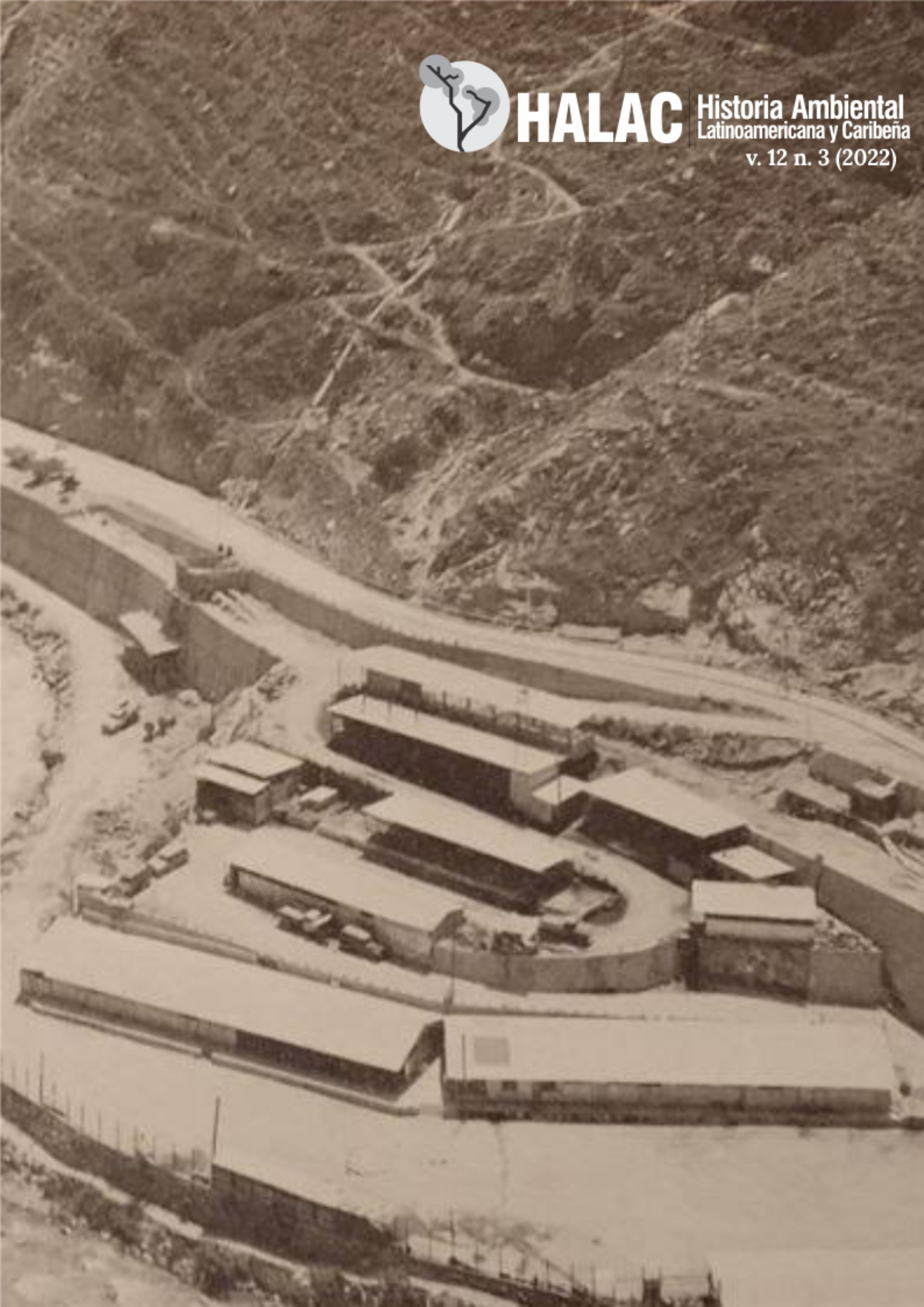Between Horizontality and Verticality: Infrastructures and Geographical Imaginaries in Post-Colonial Peru
DOI:
https://doi.org/10.32991/2237-2717.2022v12i3.p82-107Palabras clave:
infrastructure, geography, Peru, roads, hydroelectricityResumen
This article analyzes the different geographical imaginaries that emerged in Peru after independence and how they were shaped and molded by the infrastructures that were imposed upon complex landscapes. I argue that horizontal geographical conceptions of the Peruvian territory were reinforced by the development of “communication” infrastructures, specifically road building, which depicted the Andean Mountain chain as an obstacle towards national integration. Conversely, from the middle of the twentieth onwards, vertical depictions of Peruvian geography emerged, fueled by the construction of large-scale hydroelectric plants, which depended on the very complexity of Andean topography which made the construction of other types of infrastructures difficult. In this vertical conception, the complexity of the Andes not only had to be “conquered,” but also skillfully “harnessed.” Both horizontal and vertical imaginaries of Peruvian geography coexisted, furthering the notion that Peruvian geography presented both a problem and a possibility for the pursuit of national development.
Citas
Antúnez de Mayolo, Santiago. Relato de una idea a su realización o la Central Hidroeléctrica del Cañón del Pato. Lima: Editorial Medica Peruana, 1957.
Basadre, Jorge. Perú, problema y posibilidad. Lima: Librería Francesa Científica y Casa Editorial E. Rosay, 1931.
Belaúnde, Fernando Peru’s Own Conquest. Lima: American Studies Press, 1959.
Bonfligio, Giovanni. La Estadía de Antonio Gerbi en el Perú. Lima: Universidad San Martin, 2012.
Coatsworth, John. Growth Against Development: The Economic Impact of Railroads in Porfirian Mexico. DeKalb: Northern Illinois University Press, 1981.
Contreras, Carlos and Marcos Cueto, “Caminos, Ciencia y Estado en el Perú, 1850-1930,’ História, Ciências, Saúde 15, no. 3 (2008): pp. 635-655.
Contreras, Carlos. “La economía del transporte en el Perú, 1800-1914.” Apuntes, 66, (2010) pp. 59-81.
Cueto, Marcos. “Apogeo y crisis de la Sociedad Geográfica de Lima: 1888-1940.” Acta Hispanica ad Medicinae Scientiarumque Historiam Illustrandam. Vol. 12, (1992): pp. 35-45
Dagicour, Ombeline. “Construir el Estado, forjar una nación. La «nueva geografía» y su enseñanza en el Perú del Presidente Leguía (1919-1930).” Caravelle, 106, (2016), pp. 79-96
Delgado, Eulogio. “Memoria correspondiente al año 1905.” Boletín de la Sociedad Geográfica de Lima, Vol. 18, (1905): pp.3-28.
Denevan. William M., review of David A. Robinson, Peru in Four Dimensions, The Hispanic American Historical Review 46, no. 3 (1966): pp. 334-335.
Drinot, Paulo and Alan Knight, eds., The Great Depression in Latin America (Durham: Duke University Press, 2014), p. 5.
Garland, Alejandro. El Perú en 1906. Lima: Imprenta la industria, 1907.
Gerbi, Antonio, “Los Caminos del Perú,” in Geografía del Perú, ed. Emilio Romero. Lima: Ediciones del Sol, 1963.
Gobierno del Perú, Panorama de la Electrificación en el Perú. Lima: Gobierno del Perú, 1962.
Gootenberg, Paul. Imagining Development: Economic Ideas During Peru’s “Fictitious Prosperity” of Guano, 1840-1880. Berkeley: University of California Press, 1993.
Guido Pennano, “Desarrollo Regional y ferrocarriles en el Perú,” Apuntes 5, no. 9 (1979): pp. 131-51.
Harrison, J. V. “An Expedition to the Central Andes of Peru, 1939,” The Geographical Journal, 95:4 (1940) pp. 241-263.
Harvey, Penny and Hannah Knox. Roads: An Anthropology of Infrastructure and Expertise. Ithaca: Cornell
University Press. 2015.
Hidalgo, Neydo. Hidroeléctrica del Mantaro: El Arte de Hacer Luz. Lima: Electroperú, 2010.
Ministerio de Fomento. Memoria al Congreso 1940. Lima: Ministerio de Fomento, 1940.
Ministerio de Fomento. Memoria del Ministerio de Fomento. Lima: Ministerio de Fomento, 1931.
Miró Quesada, Óscar. Elementos de geografía científica del Perú. Lima: Imprenta El Comercio, 1919
Murra, John V. El mundo andino: Población, medio ambiente y economía. Lima: Instituto de Estudios Peruanos – Pontificia Universidad Católica del Perú, 2002.
Orolove, Benjamin S. “Putting Race in Its Place: Order in Colonial and Postcolonial Peruvian Geography.” Social Research 60, no. 2, (1993): pp. 301-336.
Pike, Frederick B. A Modern History of Peru. New York: Frederick A. Praeger, 1967.
Pulgar Vidal, Javier. Las ocho regiones naturales del Perú. Lima: Universidad Nacional Mayor de San Marcos, 1946.
Romero, Emilio. Geografía económica del Perú. Lima: Imprenta Torres Aguirre, 1939.
Rice, Mark. “Roads to Progress: Public Press: Public Perceptions of Highway conceptions of Highway Construction in Peru, 1920–30.” CUNY Academic Works, 2015.
Robinson, David A. “Introduction.” In Fernando Belaunde, Peru’s Own Conquest. Lima: American Studies Press, 1959.
Robinson, David A. Peru in Four Dimensions. Lima: American Studies Press, 1962.
Seoane, Manuel. Autopsia del Presupuesto Civilista: Cómo Derrocha una Casta los Dineros del Pueblo. Buenos Aires: Comité Aprista Peruano, 1936.
Smith, Neil. Uneven Development: Nature, Capital, and the Production of Space. New York: Blackwell, 1984.
Stiglich, German. Geografía Comentada del Perú. Lima: Casa Editora Sanmartí & Cía., 1913.
Werlich, David. Peru: A Short History. Carbondale: Southern Illinois University Press, 1978.
Descargas
Publicado
Cómo citar
Número
Sección
Licencia
Derechos de autor 2022 Gonzalo Emilio Julio Romero Sommer

Esta obra está bajo una licencia internacional Creative Commons Atribución-NoComercial 4.0.
Esta revista ofrece acceso libre inmediato a su contenido, siguiendo el principio de que disponibilizar gratuitamente el conocimiento científico al público proporciona mayor democratización mundial del conocimiento.
A partir de la publicación realizada en la revista los autores poseen copyright y derechos de publicación de sus artículos sin restricciones.
La revista HALAC sigue los preceptos legales de la licencia Creative Commons - Atribución-NoComercial 4.0 Internacional. 




